ST1711
Create successful ePaper yourself
Turn your PDF publications into a flip-book with our unique Google optimized e-Paper software.
OPINION<br />
OPINION: STORAGE NETWORKS<br />
TESTING THE LIMITS OF<br />
STORAGE NETWORKS<br />
REVOLUTIONARY ADVANCES IN DATA STORAGE<br />
TECHNOLOGY REQUIRE A CONSIDERED RESPONSE<br />
WHEN IT COMES TO TESTING, ARGUES TOM<br />
FAWCETT, VICE PRESIDENT AND GENERAL MANAGER<br />
AT VIAVI SOLUTIONS<br />
As businesses embrace a brave new<br />
digital world, enterprise IT is striving to<br />
accommodate unprecedented growth in<br />
data, while at the same time supporting<br />
increasingly complex workflows. Likewise,<br />
pressure to reduce costs and energy<br />
consumption has prompted increased adoption<br />
of cloud and cloud-native applications; a trend<br />
compounded by the expectation that Service<br />
Level Agreements (SLAs) will ensure on-demand<br />
access to information anytime, anywhere.<br />
As a result, the traditional data centre is<br />
compelled to undergo revolutionary<br />
transformation. Correspondingly, data storage<br />
technology has advanced rapidly to enable<br />
management of more data, with faster delivery<br />
speeds, across hybrid network environments.<br />
LINKING STORAGE<br />
Since the advent of the IP-based networking<br />
standard iSCSI, ultra-low latency Ethernet<br />
switching technology has advanced to<br />
become a viable means of linking data<br />
storage facilities, enabling a converged data<br />
centre storage model. Ethernet networks are<br />
now being effectively used to build Storage<br />
Area Networks (SANs).<br />
Converged Ethernet fabric architectures,<br />
such as NVMe over Fibre, Fibre Channel over<br />
Ethernet (FCoE) and RDMA over converged<br />
Ethernet (RoCE), accelerate data transfer over<br />
the network fabric, connecting servers and<br />
storage systems. Network professionals have<br />
adopted these technologies, reducing both<br />
latency and cost. However, the introduction of<br />
new storage technologies introduces new<br />
troubleshooting challenges concerning<br />
performance and reliability of business<br />
critical applications.<br />
When implementing an Ethernet storage<br />
network there are a number of potential<br />
problems to be mindful of, including TCP/IP<br />
and iSCSI errors, protocol violations,<br />
connection sequence errors, and establishing<br />
with certainty if pings are working. Any errors in<br />
these areas can interfere with secure and<br />
reliable storage and the retrieval of missioncritical<br />
data.<br />
STORAGE SHOULDN'T BE TESTING<br />
To prevent potential errors from impeding<br />
business productivity, IT administrators and<br />
storage solution suppliers rely on a variety of<br />
network test and measurement tools. However,<br />
as more competing application protocols<br />
converge over Ethernet, a dizzying array of tests<br />
and tools has proliferated for each specific<br />
technology or protocol, challenging IT<br />
managers to choose or risk busting the budget.<br />
Fortunately, there is a trend toward multiprotocol<br />
test and analysis tools capable of<br />
supporting all predominant speeds and<br />
application-level protocols.<br />
VIRTUAL REALITY CHECK<br />
In addition to adopting converged Ethernet<br />
technologies to reduce latency, data centres are<br />
embracing virtualisation to increase storage<br />
network capacity. Virtualisation enables the<br />
sharing of physical resources among many<br />
virtual machines (VMs) to manage I/O<br />
infrastructure efficiently. It also creates new<br />
challenges for storage administrators.<br />
With the consolidation of many virtual<br />
servers on just a few storage devices, virtual<br />
storage networks are prone to bottlenecks as<br />
VMs compete for storage resources.<br />
Moreover, the relationships among VMs,<br />
physical hosts and the storage device are<br />
highly fluid and dynamic, increasing the<br />
complexity of storage networks. This means<br />
that visibility into the network tends to be<br />
limited, making it difficult to isolate whether<br />
performance issues are originating on the<br />
local area network (LAN), the server, or the<br />
storage network. Because they are shared by<br />
many applications, virtualised infrastructures<br />
undergo frequent changes in load patterns.<br />
As the numbers of VMs multiply the result is<br />
an I/O blender effect where predictable<br />
patterns become randomised, creating<br />
dynamic points of congestion and raising the<br />
likelihood of intermittent problems. These<br />
random issues can only be detected by<br />
analysing I/O load patterns, therefore greater<br />
visibility into I/O workloads is needed to<br />
diagnose and correct these issues. This<br />
requires an ability to capture storage traffic<br />
being generated at different infrastructure<br />
locations in real time.<br />
As storage networks grow in complexity and<br />
importance to overall business value,<br />
performance and reliability of each piece of<br />
infrastructure is critical to productivity and profit.<br />
Today's advanced testing tools designed for nextgeneration<br />
technologies and protocols enable<br />
faster, more accurate troubleshooting and<br />
deeper analysis, preventing network downtime.<br />
More info: www.viavisolutions.com<br />
^<br />
30 STORAGE Nov/Dec 2017<br />
@STMagAndAwards<br />
www.storagemagazine.co.uk<br />
MAGAZINE

















